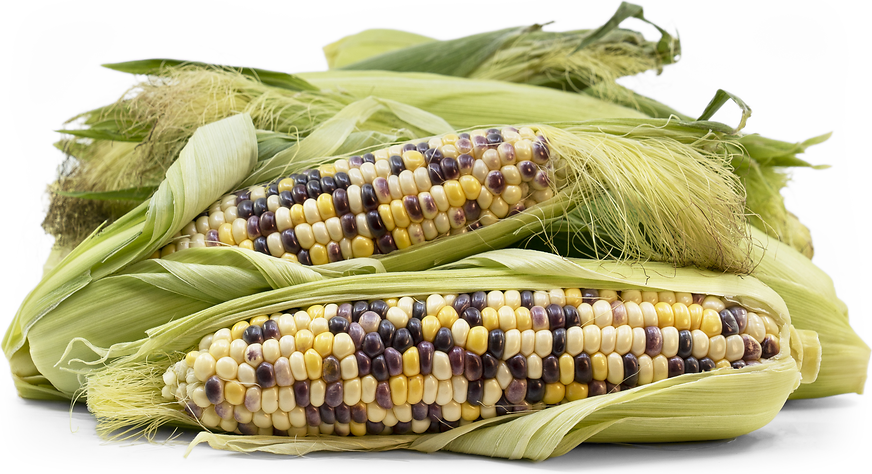


Wild Violet Corn
Estimated Inventory, ear : 0
Description/Taste
Wild Violet corn is a small to medium-sized varietal, averaging 12 to 18 centimeters in length, and has an elongated, cylindrical shape with blunt ends. The cobs are tightly wrapped in layers of dark to light green husks with thin, pale-yellow fibers known as silks that act as a layer between the husk and cob. The husks also have a ridged, textured surface and fibrous, inedible nature. When the husks are peeled, a plump cob is revealed, covered in densely packed kernels. The kernels have a semi-glossy appearance and a curved, smooth, and taut surface, showcasing shades of violet, dark purple, and ivory. Wild Violet corn should be harvested when some of the kernels on the cob have just begun turning a light violet-purple hue. As the cobs age, the purple shades will darken. Wild Violet corn is fleshy, aqueous, and tender with a crisp, succulent consistency. The bi-colored corn is high in sugar and low in starch, creating a sweet and subtly nutty flavor. It is important to note that the longer the ears are stored, the more the sugars will begin to convert to starch in the flesh, creating a doughy flavor and consistency.
Seasons/Availability
Wild Violet corn is available in the summer.
Current Facts
Wild Violet corn, botanically classified as Zea mays, is a mid-season bi-colored variety belonging to the Poaceae family. The hybrid cultivar was created in Idaho in the early 21st century as an improved sweet corn variety. Wild Violet corn grows on tall, upright stalks reaching 1.8 to 2 meters in height and takes approximately 75 days to mature for harvest. The variety is one of the first bi-colored corns featuring purple-hued kernels that do not lose their pigmented nature when cooked. The variety was created using traditional breeding practices and is not genetically modified. Wild Violet corn has a rich, sweet taste mixed with classic corn flavors and is consumed fresh or cooked.
Nutritional Value
Wild Violet corn, like other sweet corn varieties, is a source of fiber to regulate the digestive tract, folate to produce red blood cells, and potassium to balance fluid levels within the body. The sweet corn also provides vitamin C to strengthen the immune system, magnesium to help transform food into energy in the body, and other nutrients, including B vitamins, iron, zinc, and copper. The purple pigments in the kernels signify the presence of anthocyanins, natural compounds that have antioxidant-like properties to protect the cells in the body from external environmental damage.
Applications
Wild Violet corn has a soft and sweet flavor suited for fresh and cooked preparations. The corn can be sliced from the cob and consumed raw in green salads, mixed with herbs as a side dish, or used as the added crunch on appetizers, grain bowls, and salsa. The kernels can also be lightly stir-fried, sauteed, or roasted, incorporated into side dishes, or topped over cooked meats. In addition to slicing the kernels from the cob, Wild Violet corn cobs can be cooked whole, boiled in water or coconut milk for flavor. The cobs can also be baked and eaten like traditional sweet corn with sauces, butter, and spreads. A distinguishing feature of Wild Violet corn is its purple coloring. The purple hues are not lost in cooking, nor do they bleed into the dish. The violet hues deepen with cooking, eventually transitioning into a deep indigo hue. Wild Violet corn can be cooked into casseroles, simmered into soups, made into patties, and cooked into fritters, combined into pasta, stirred into creamy dips, or pureed and baked into a crisp crust. Wild Violet corn is versatile and pairs well with cucumbers, bell peppers, tomatoes, avocado, aromatics such as garlic, red onion, ginger, and shallots, cheeses including feta, burrata, and parmesan, and herbs such as thyme, basil, cilantro, and parsley. Whole, uncooked Wild Violet corn will keep 1 to 3 days when stored in the refrigerator in a partially opened bag in the crisper drawer. The cobs can also be frozen whole, or the kernels can be removed from the cob and frozen for around six months.
Ethnic/Cultural Info
Wild Violet corn is fifty-six to sixty percent purple and forty to forty-four percent white. Despite its genetic design, some Wild Violet corn may showcase some yellow kernels, a natural product of wind pollination. If Wild Violet corn is grown beside a field of yellow sweet corn, pollen from the yellow variety may drift in the wind over to the Wild Violet cornfield, mixing the genetics of the two species. This pollination creates yellow kernels on the multi-colored corn, changing the variety's appearance, but the flavor remains primarily unchanged.
Geography/History
Wild Violet corn was created by the Crookham Company based in Caldwell, a city in the Treasure Valley of Idaho. Treasure Valley was once known as the Boise River or Lower Snake River Valley and was renamed in 1959 through the efforts of businessman Pete Oleson, the city's President of the Chamber of Commerce at the time. Oleson wanted to highlight the region's potential for urban and agricultural opportunities, rebranding the area as Treasure Valley. The Crookham Company was established in 1911 by George L. Crookman and was initially created to sell popcorn seeds. Over time, the business expanded to breed other types of corn and was one of the first companies to produce hybrid sweet corn commercially. The Crookham Company took over ten years to breed Wild Violet corn, and the variety was officially released to the public in the spring of 2020. Wild Violet corn was created using natural, traditional breeding techniques and is grown commercially across the United States, sold through distributors, national grocers, and specialty retailers. The variety is also offered through online seed retailers for home garden use.
Recipe Ideas
Recipes that include Wild Violet Corn. One
| Sparkling Charm |
|
Wild Violet Sweet Corn Salsa |




